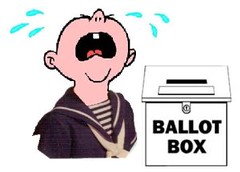The spoiler effect is usually described by example. There are three candidates, with two of the three being favored by a majority of voters equally. Using plurality voting, votes for those two candidates
would split about equally, allowing the third candidate to win election. Surely it is a stain on any voting system to allow this sort of electoral miscarriage to happen. If such a thing can happen then eventually it will; with plurality voting it has happened.More broadly, the spoiler effect is characterized as an electoral win that disappoints a majority of voters because of votes being arbitrarily split between two or more similar candidates. This is not something that should happen in a democracy. The lesson to draw is that it is a dangerous flaw in a voting system when it insists that a voter, who may have no such preference, must nonetheless vote to give an advantage to one of two similar candidates.
In the previous article we explored an example of a flawed election using ranked-choice voting (IRV). That example election is between five candidates with voters considering four of the candidates to be equally suited for election. Only a minority of the voters prefer the one remaining candidate but that is the candidate who wins election. One might argue that this fails to be a clear example of the spoiler effect because the outcome depends on the defective way that IRV treats abstentions more than it does on the perceived similarity of candidates. Vote splitting does happen, however, and the election outcome does disappoints the majority of voters who would have preferred any of the other candidates. If it is judged not technically an instance of the spoiler effect at work, the example remains no less of an electoral miscarriage, and this possibility is still as much of a stain on democracy.
An IRV enthusiast might also counter that voters can be educated to avoid making this error. It seems doubtful such a campaign of education could be entirely successful, but the example that is to follow
shows that the spoiler problem remains even if it is possible to successfully train the voters.More promising than trying patch up IRV or minimize its flaws would be to adopt the BAV voting system. BAV measures both the level of support and the level of opposition to a candidate; when support and opposition are both measured, the level of indifference toward a given candidate can be derived by subtracting both support and opposition from the count of ballots. Moreover, with BAV, voters can always treat identical candidates identically (this is also true for approval voting). And finally, we might recall that BAV will level the playing field and so guarantee more even-handed treatment, even of candidates who are not especially famous.
We could consider the spoiler effect to occur when a candidate wins election despite the opposition of a majority of the voters. But when an election uses plurality voting (or many other voting systems) such an electoral blunder might simply go unnoticed; the only indication of such a failure would be a widespread malaise among voters, something that could easily be misinterpreted. Most voting systems do fail to take any measure of voter opposition to candidates; they often measure support only (and consequently non-support). But opposition may be only a small portion of non-support, particularly when it comes to independent candidates or those from small parties; voters who know too little about a candidate tend neither support nor oppose the candidate.
IRV not only fails to measure opposition; it even fails to ask voters anything about support for candidates. IRV is sometimes labeled as an ordinal voting system because it asks voters only to order the candidates according to the degree of support. Does that provide sufficient information to determine the appropriate winner? An ordered list of ten candidates may reflect support for none of them or perhaps just the first one or two. It is equally consistent with support for all of them.
An example may help to appreciate the complexity of the IRV voting system, even though assuming that the voters have been well trained to avoid the natural temptation of skipping over unrecognized candidates to put their least favorite candidates at the end of the list.
Consider an IRV election where the 12,500 submitted ballots are as follows:
Notice that candidate D has 6000 supporters who specify no second choice. In contrast, it appears that their supporters consider candidates A and B to be similar; their votes appear to split between A and B, but these voters show a preference for C once both A and B are eliminated.
Notice that, like D, A has a (smaller) following who specify no second choice. D's supporters represent 48% of the voters while A, B and C share the other 52% of the voters. Since we assume the voters are all well-trained, we know that they do support all the candidates that they list on the ballot. With that assumption we can reasonably judge that a majority of voters likely oppose D.
In the first round, B is eliminated, leaving votes distributed as follows:
With only 3200 votes, A is eliminated in this second round and afterward there are 1200 fewer ballots to be counted. This causes D's tally, still of 6000 votes, to become a majority with (53%) of the remaining 11,300 ballots. Despite being opposed by a majority of voters, D wins this spoiled IRV election.
This example exploits the complexity of IRV with multiple counts and re-counts. The first two ballot tallies eliminate a block of voters and in turn, leads to this defective electoral outcome. Notice that with IRV, the placement within the list can affect the election outcome. The underlying issue is that IRV voters are forced into distinguishing between candidates they view as essentially similar by putting one arbitrarily before the other. The same can happen using the balanced voting system, instant runoff balanced voting (IRBV) so perhaps IRBV also enables such spoiled elections.
Some of the appeal of IRV is likely that it provides an easy response to the "one man, one vote" mantra. In each round of voting there is only one vote per ballot and the voter specifies how that one vote transfers to another candidate in successive rounds. This resembles an actual series of elections. But insisting on a strict interpretation of the "one man, one vote" mantra fails with women allowed to vote. Why cannot we also relax it when interpreting the meaning of "vote".
Facing this issue directly as we did in an earlier article we would recognize that "One man, one vote" probably originated as phrase for a crowd to chant during a campaign to improve democracy. No doubt chosen more for its rhythm and concision, it is doubtful it was considered as a precise and thoughtful expression of electoral philosophy.
In a modern context, a more accurate rendition might be that "every voter should have an equal voice in the election". Clearly, that would be an awful failure as a chant but as a guideline for fair voting it would be better suited as a statement of principle. Alternatively, the modern version could still say "one voter, one vote" if only we would accompany a more relaxed interpretation for the noun "vote".
(Article changed on Dec 02, 2023 at 2:18 PM EST)
(Article changed on Dec 02, 2023 at 3:44 PM EST)









